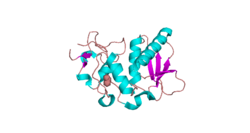Knochenmorphogenetisches Protein 1
| Knochenmorphogenetisches Protein 1 | ||
|---|---|---|

| ||
| nach 3EDG | ||
| Eigenschaften des menschlichen Proteins | ||
| Masse/Länge Primärstruktur | 866 Aminosäuren | |
| Kofaktor | Zn2+, Ca2+ | |
| Isoformen | 7 | |
| Bezeichner | ||
| Gen-Name | BMP1 | |
| Externe IDs | ||
| Enzymklassifikation | ||
| EC, Kategorie | 3.4.24.19, Metalloprotease | |
| MEROPS | M12.005 | |
| Reaktionsart | Spaltung von Peptidbindungen | |
| Substrat | Ala-+-Asp / Arg-+-Asp in Procollagen-I/II/III und Pro-ApoA1 | |
| Produkte | Collagen-I/II/III, ApoA1 | |
| Vorkommen | ||
| Übergeordnetes Taxon | mehrzellige Tiere[1] | |
| Orthologe | ||
| Mensch | Hausmaus | |
| Entrez | 649 | 12153 |
| Ensembl | ENSG00000168487 | ENSMUSG00000022098 |
| UniProt | P13497 | P98063 |
| Refseq (mRNA) | NM_001199 | NM_009755 |
| Refseq (Protein) | NP_001190 | NP_033885 |
| Genlocus | Chr 8: 22.16 – 22.21 Mb | Chr 14: 70.47 – 70.52 Mb |
| PubMed-Suche | 649 | 12153
|
Knochenmorphogenetisches Protein 1 (BMP1) ist ein Protein, dessen Homologe in allen mehrzelligen Tieren nachgewiesen werden können. Beim Menschen hat BMP1 einerseits die Funktion eines Wachstumsfaktors, der die Differenzierung von Mesenchym-Zellen zu Osteoblasten auslösen kann, andererseits hat BMP1 enzymatische Aktivität: als Peptidase spaltet es die Vorstufen der Collagene I, II und III sowie von Apolipoprotein A1. Es ist daher wichtig für die Knorpelbildung und den reversen Cholesterintransport. BMP1 ist das einzige knochenmorphogenetische Protein, das nicht zur TGF-beta-Superfamilie (Transforming growth factor) von Zytokinen gehört. BMP1 gehört zu den Metalloproteasen.[2][3][4]
BMP1-Inhibitoren haben in Zell- und Tierstudien das Potenzial gezeigt, in Narbencremes eingesetzt zu werden.[5][6][7]
Weblinks
- D'Eustachio/Jassal/reactome: Conversion of pro-apoA-I to apoA-I
Einzelnachweise
- ↑ Homologe bei OMA
- ↑ UniProt P13497
- ↑ H. Ibelgaufts/COPE: BMP
- ↑ Chau P, Fielding PE, Fielding CJ: Bone morphogenetic protein-1 (BMP-1) cleaves human proapolipoprotein A1 and regulates its activation for lipid binding. In: Biochemistry. 46, Nr. 28, Juli 2007, S. 8445–50. doi:10.1021/bi700028u. PMID 17580958.
- ↑ Bailey S, Fish PV, Billotte S, et al.: Succinyl hydroxamates as potent and selective non-peptidic inhibitors of procollagen C-proteinase: design, synthesis, and evaluation as topically applied, dermal anti-scarring agents. In: Bioorg. Med. Chem. Lett.. 18, Nr. 24, Dezember 2008, S. 6562–7. doi:10.1016/j.bmcl.2008.10.036. PMID 18945617.
- ↑ Reid RR, Mogford JE, Butt R, deGiorgio-Miller A, Mustoe TA: Inhibition of procollagen C-proteinase reduces scar hypertrophy in a rabbit model of cutaneous scarring. In: Wound Repair Regen. 14, Nr. 2, 2006, S. 138–41. doi:10.1111/j.1743-6109.2006.00103.x. PMID 16630102.
- ↑ Zhang Y, Ge G, Greenspan DS: Inhibition of bone morphogenetic protein 1 by native and altered forms of alpha2-macroglobulin. In: J. Biol. Chem.. 281, Nr. 51, Dezember 2006, S. 39096–104. doi:10.1074/jbc.M601362200. PMID 17071617.